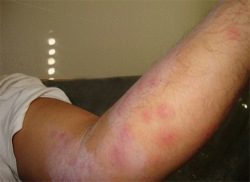Some of the indications of bed bug infestation are the presence of bite marks on the skin, dark spots on sheets, fecal stains, blood stains, skin sheds, and empty exoskeleton. By identifying bed bug bites you are able to treat them quicker. Common places to find bed bug bites are parts of the body that are exposed at night when you are asleep such as face, neck, legs, arms, and shoulders. Generally, the bites appear in clusters or rows of straight lines. Bed bug bites are characterized by red marks that become itchy or inflamed over time. Different people react differently to bed bug bites, and whereas some might show a reaction to the bites within a few days, others don’t show any reaction.

The size of bite on an individual is dependent on two factors namely the number of times an individual is bitten, and how a person reacts to the anticoagulant injected by the bed bug during feeding. For the first factor, an increase in the number of bites will affect the way people some persons reacts, and this will also determine the size of the bites. Secondly, different humans react differently to the anticoagulant injected into the skin during feeding. Some persons will show intense reaction leading to the massive size of bite marks, while others will show mild reaction leading to smaller bite marks.
Bed bugs have a protruding beak through which they feed on blood. With the aid of an anesthetic which they inject during feeding, the sharp pain usually goes unnoticed, allowing them to feed for a long time without any disturbance. As earlier mentioned, bed bug usually bites exposed skin while you sleep. [Read more…]
Bite symptoms
General symptoms include red welts, severe itching, bumps, and rashes. Sometimes allergic reactions may be experienced by certain individuals. In some instances, some individuals don’t show any form of reaction to bed bug bites.
Typical bed bug bites appear in a series of straight lines and clusters as well. Bites can lead to rashes, blisters, skin inflammation, red bumps, and burning sensation on the skin. Excessive scratching of the bite area can lead to skin infections.
Why do bed bugs bite?
Without blood bed, bugs can’t survive, and even though some might go months without feeding, they still depend on blood for survival and reproduction.
Bed bugs don’t just feed on the first place they bite; they have to locate the right blood vessel that can meet their hunger requirements and this usually takes a couple of injection into the skin. They like their meal source to be stationary hence why they prefer to feed at night. Any sudden movement of the host means they will have to start the fed process again. Note that the number of bite marks on the skin doesn’t correlate with the number of bed bugs that feasts on the individual, it might just be one-bed bug looking for a suitable blood vessel, hence the many bite marks.
Risks of infection
Excessive scratching of the bite marks can lead to the further opening of the skin, which might become an entrance to secondary infections. Secondary infections are mainly common among people with weak immune systems, such as children, and the elderly.
Bed bugs on pets
Bedbugs act the same way on pets as they do on humans. Sometimes bed bug bite might be mistaken for a flea bite or mosquito bite because of the close similarities. Pay attention to your pet, and watch for excessive itching and scratching. Also, you might want to check the beddings of the pets to see if there are any signs of bed bugs. Regular bathing of your pet can help prevent bed bugs on their bodies. You should ensure you hot wash all pets clothing and bedding materials to eliminate any bed bugs lurking in the shadows.



